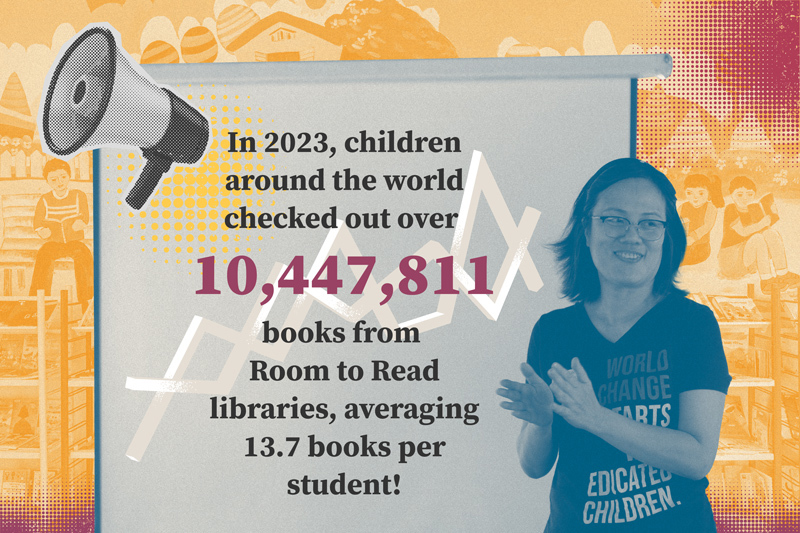Measuring impact: The journey of Room to Read data
April 28, 2025

By
Manager, Data and Learning
Room to Read's Research, Monitoring and Reporting Team
At Room to Read, learning is at the core of everything we do — and data plays a vital role in helping us grow, improve and benefit more children, more effectively and more quickly. By carefully monitoring and evaluating our programming, we identify what’s working and discover opportunities to strengthen our approach.
How exactly do we use data?
To give you an idea, let’s look at how we track book checkout rates from Room to Read libraries, an important metric in measuring how children engage with our libraries and build a regular habit of reading. In 2023, children around the world checked out over 10.4 million books, averaging 13.7 books per student! This remarkable engagement speaks to the love of reading fostered through our libraries.
But behind these figures, is a rigorous process — one that involves gathering, verifying, analyzing and sharing data to guide meaningful improvements. Here's how the journey of our data unfolds:
Data collection
 It all begins with gathering data from Room to Read libraries, schools and communities. This includes completing the library rating system inventory to ensure all library components are in place, reviewing monthly book checkout summaries, and cross-checking with individual student book checkout forms. Whenever possible, we use secure, tablet-based software to collect this data efficiently and accurately.
It all begins with gathering data from Room to Read libraries, schools and communities. This includes completing the library rating system inventory to ensure all library components are in place, reviewing monthly book checkout summaries, and cross-checking with individual student book checkout forms. Whenever possible, we use secure, tablet-based software to collect this data efficiently and accurately.
We also collaborate with partner organizations to capture reliable information from activities that allow us to reach more children, more quickly.
For book checkouts, this involves visiting schools at the start of the academic year to collect enrollment records and monitoring book checkout data uploads each month.
Data verification
 We conduct rigorous quality control checks to ensure the data is complete and reliable.
We conduct rigorous quality control checks to ensure the data is complete and reliable.
This includes school visits where we cross-check students’ book checkout records with library monthly summary records to ensure no details are missed.
Data integration
 Once verified, the data is compiled into a centralized database, where it is organized by programmatic areas and priorities. This creates a comprehensive view of our global operations and outcomes.
Once verified, the data is compiled into a centralized database, where it is organized by programmatic areas and priorities. This creates a comprehensive view of our global operations and outcomes.
Data analysis
 Our Research, Monitoring & Evaluation team dives into the data and identifies key trends across regions, countries and our global portfolio.
Our Research, Monitoring & Evaluation team dives into the data and identifies key trends across regions, countries and our global portfolio.
These insights often spark curiosity and lead to further research, such as our Habit of Reading Assessment. This allows us to dig deeper and evaluate how our libraries influence children's reading habits and literacy skills.
Why It Matters
We take great pride in our commitment to being a learning organization. Data allows us to develop and deliver evidence-based materials and approaches focused on foundational literacy and life skills that promote gender equality.
It all starts with data — and a passion for learning that drives us forward.
This blog post was developed in collaboration with Room to Read's Research, Monitoring and Evaluation team members Jacktan Magesa, Rehema Dulla, Denis Mosha, Wade Harker and Kaushlendra Kumar.

 Throughout the journey from data collection to analysis, sharing results is essential to guiding daily decision-making and driving programming improvements.
Throughout the journey from data collection to analysis, sharing results is essential to guiding daily decision-making and driving programming improvements.

